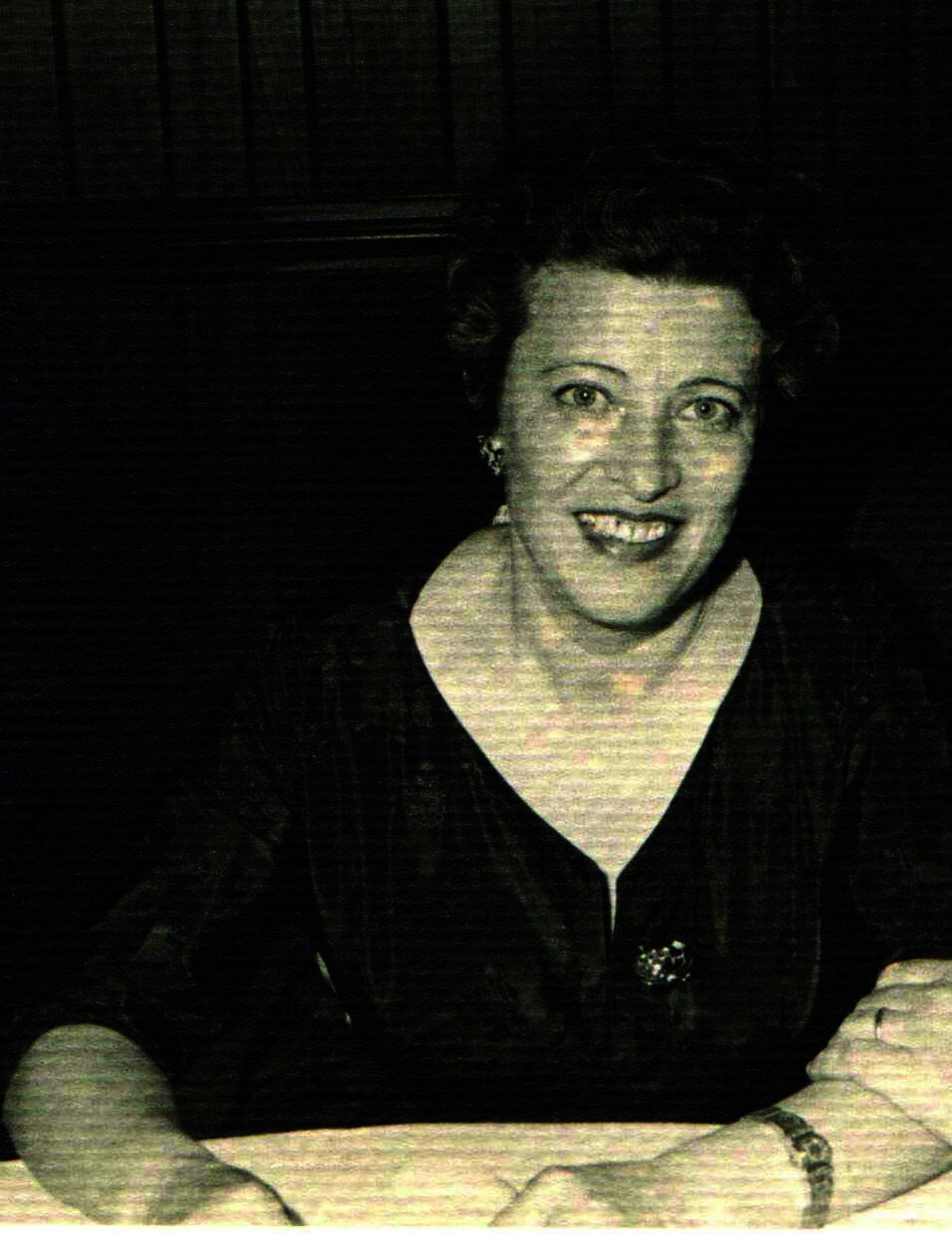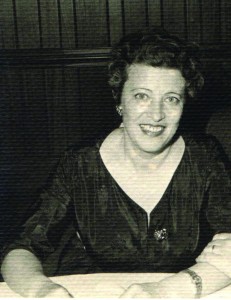Recently published, To Life: The Past is Present: Holocaust Stories of Hampton Roads Survivors, Liberators and Rescuers, is the book’s second edition. This anthology contains recollections of ghetto and concentration camp survivors, hidden children, Jews on the run, refugees, and of daring, selfless rescuers who made their home in Hampton Roads following the Holocaust and World War II.
Following is an excerpt of Anna (Chana) Shapiro Burk’s story. To learn more about the many other brave individuals who fill the pages of To Life: The Past is Present, visit
www.holocaustcommission.org/.
Anna (Chana) Shapiro Burk
A sister’s love and strength
helped her survive
Edited by Frieda Igdal
At the beginning of World War II, (Chana Meri) Anna Shapiro lived with her widowed mother and two sisters in Pakruojis, Lithuania. They resided in a building that her mother owned in which she also operated a small hotel, the Hotel Europa, and a grocery store. After graduating from high school, and aside from being trained as a midwife, Anna was helping her mother with the business, and as a family, they were quite comfortable financially. Due to the Communist occupation of the Baltic states, Anna Shapiro and her friend Rita Sands left home in January 1941 to seek employment in the city of Kovno (now Kaunus). Anna’s sister, Ruth (Rivka), joined them on June 21, 1941. Upon Ruth’s arrival, the German Army had started to invade the city and were also bombing it by air. As flames engulfed the city, the women rushed into a house near the station, where they waited in hiding with other Jews for two days.
Realizing there was no way for them to return home to Pakruojis, they headed the 60 miles for Vilna, Poland (now Vilnius, Lithuania), by foot. When they reached Vilkomir, Luthuania, the Nazis, parachuting into the town, forced them to return the 43 miles to Kovno. There they were ordered into a large building full of other Jews, and commanded not to leave except to pick up their rations from a local store. Getting to the store was its own humiliation, as they were forced to walk in the gutter, barefoot, and in single file, where they were rationed a piece of bread, some grits, and salt.
In Kovno in late June, Anna’s sister, Ruth, and a friend were captured and taken to the Seventh Fort massacre. They escaped, and Anna was sitting shiva for her sister when they met again.
The Ghetto. On July 15, 1941, Anna and her sister Ruth entered the Kovno Ghetto and were forced to wear the black and yellow cloth bearing the Star of David on their chests. The ghetto was enclosed a month later with barbed wire; reflectors were strategically placed, and it was heavily guarded by Nazi, Lithuanian, and Ukranian police. Anna and Ruth lived with eight other people in two small rooms, sleeping on the floor. Twice a week they would get rations from the Nazis, as the ghetto had no shops. Their ration continued to be a small portion of bread, grits, and salt, and once a week they received some horse meat, some rotten herring, and rotten potatoes, which gave the ghetto a particular stench.
On August 18, 1941, Anna’s fiancé was collected and murdered at the Fourth Fort action. This was the murder of the intelligentsia; her fiancé had been a journalist, an occupation unacceptable for a Jew. She sat shiva for a second time in two months.
The ghetto’s commandant, a man named Jordan, was known for his cruelty. All Jews were roused at 5 a.m. daily and lined up by the ghetto’s gate. From there, they were divided into groups of several hundred, and walked to designated working areas by Nazi police carrying guns, whips, and clubs.
A cruel job involved unloading food for the military from trains. The workday diet was a watery soup made from potato peelings. None of the workers was paid for the forced labor.
While working on the military trains, Anna met Dovid Igdalski, and together they arranged for their siblings, Rivka and Israel, to marry as an attempt for protection from the Nazis. It was a success both in the ghetto and for the rest of their lives.
After two or three weeks in the ghetto, Anna and the others were ordered by Commandant Jordan into the courtyard. Two rows of Gestapo men faced each other, and the ghetto residents had to walk between them, ordered to the left or the right. This lasted about 12 hours.
When the line ended, those on the right, like Anna and Ruth, were ordered back to their quarters. If separated family members tried to reach each other on the other side, they were beaten unmercifully. Those unfortunate souls ordered to the left were taken under guard out of the ghetto, shot, and thrown into graves which the Jews had been compelled to dig.
In 1943, Anna, still in the Kovno Ghetto, contracted typus from the unsanitary conditions and her weakened condition after two years of forced labor. At age 24 she weighed 65 pounds. She was confined to her room for three months, where she was secretly treated by a kind doctor. The Judenrat worked very hard to keep the epidemic secret so the Nazis would not know Anna or anyone else was absent from work shifts. After recovering, Anna was assigned to work building the Kovno airfield, where she dug ditches, mixed cement, carried steel beams, and pushed wheelbarrows filled with dirt, stones, or cement. As they performed this and other heavy labor, their Nazi overseers beat them at will. She learned that the Nazis had killer her mother and her other sister.
After recuperating from her illness, Anna and her friend Frieda escorted Frieda’s infant daughter out of the ghetto into the waiting arms of a close non-Jewish friend, a teacher. Twenty-seven years later, that baby, Ruta, was found and reunited with her family in Israel.
Gifangen Concentration Camp. On November 30, 1943, Anna was ordered from the ghetto to Gifangen Concentration Camp, previously a Lithuanian military installation in a Kovno suburb called Aleksotas. There, about 1,500 men, women, and children were housed in a large brick building. The camp itself was surrounded by barbed wire and each corner had reflectors. The daily routine was equivalent to the Kovno Ghetto, with Nazi police always on guard.
Stuthoff. In July of 1944, Anna and Ruth were two of about 50 women loaded onto a boxcar. Men were loaded into other cars, and the train set off for several days with hardly any food and no ventilation, eventually arriving at the concentration camp at Stutthof. Walking into the camp, Anna saw the crematorium, and she also saw something behind it that looked like a mountain. But as she looked closer, she realized that it was a huge pile of shoes and clothing left behind by the people who had lost their lives and burned in the ovens.
Stutthof was surrounded by electrified barbed wire and hundreds of police with clubs, pistols, and machine guns. The new prisoners were taken into a large white building where they slept on the floor. The next morning the Nazis marched the men away, and an hour later herded the women into the yard. They were taken into a building and ordered by the guards to strip naked, walk into yet another room. The officers then commanded the soldiers to go through Anna’s and the others prisoners’ hair and mouths to search for hidden money or jewelry.
In a third room, the indignity continued as each woman had a pelvic examination by a doctor to look for more valuables internally. After this horror, they were packed into yet another room, and promised a shower, but only with a few drops of water. Their last stop was another room with mounds of clothing on the floor. They were told to take one garment, whether it fit or not, and then to pick a pair of shoes. From the time they entered the building to be searched until they picked up their “new” shoes, 24 hours had passed with no food or drink. There was just one huge line of people walking from room to room.
Anna was then taken into a wooden barrack housing hundreds. Each barrack had only one small door, so only one person could enter or exit at a time. Like other camps, there was electrified barbed wire encompassing the prisoners’ world. After three weeks at Stutthof, she was taken on a small ship with 500 women to Dorf Sztynort, where they were housed in shelters made of what looked to her like heavy cardboard. Each was round and housed about 50 women, who slept on the straw-covered ground. There were no sanitary facilities. Anna was again forced to dig trenches and bunkers.
On January 21, 1945, Anna got up to report to work as usual, but was told that they were going to a new place to work. But as the Nazis were talking, the bombs kept falling, and she thought the Nazis were bombing the prisoners. She and the other women who survived the bombing were forced to walk without food or rest. Those who fell by the wayside were shot by the Nazis. This was the beginning of the Stutthof death march.
Liberation. Those who survived were forced into various buildings. Anna and her sister found shelter in a haystack in the loft of a barn. Before leaving, the Nazis bayoneted the haystacks, seeking stragglers. Luckily, the two were not found. They hid in the haystacks for seven days surviving on icicles. Slowly, the prisoners began to recognize the singing of Russian songs. Soon Russian soldiers arrived and asked the women who they were. When they told the Russians they were Jews in Nazi servitude, the Russians told them that they were free, and that they need have no further fears. This day, which Anna would always remember was January 25, 1945. The place was Redzikowo, Poland.
The Russians took them in trucks to a deserted village in Poland where Jews, most of whom had barely any clothes on their backs, were told they could enter any home and make themselves comfortable. Anna and Ruth stayed there for one week. Then the sisters and four other women decided to return to their hometown of Pakruojis. They got as far as Bialystok, Poland in an open-topped railroad car. There the train stopped, and they were told they could disembark for a while, as there would be a considerable delay.
They walked into town, and noticed some other Jewish people. Those Jews, members of the Bricha (a Jewish relief agency that helped Jews get to Palestine during WWII), advised them to remain there, since Bialystok had a Jewish Committee that would advise them where it would be best for them to go. Anna and her comrades took the advice and remained there until after Passover. Then the Jewish Committee sent them to Budapest, Hungary, where they stayed for two weeks. It was the first time in almost four years that Anna was treated well and lived like a civilized human being. The refugees were given food and clothing, and examined by real doctors.
Postwar. After departing from Budapest they traveled to the Ludus Kibbutz, a Bricha training camp, from which they planned to immigrate to Israel. Instead, because of Ruth’s illness, they headed for Vienna and resided in the Rothschild Hospital, where they remained until June 5, 1946. While in Vienna she met Chil Berkowitz, her future husband, on June 7, 1946. Soon, the newlyweds immigrated to the United States of America.
POSTSCRIPT
Anna and Chil, who later changed his name to Charles, had one son, Franklin Robert, who was born in 1947 and died in 1997. Anna died in February 1998.
Anna’s husband, Charles, sister, Ruth Igdal, and brother-in-law, Irving Igdal, are also included in the book.
–Elka Mednick


